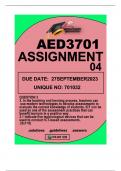,AED3701 ASSIGNMENT 04 DUE 27SEPTEMBER2023
QUESTION 1
1.1 When developing assessments, it is crucial to make sure that
every learner is given a fair and just chance to achieve the desired
results, according to their cognitive ability.
1.1.1 Draw and label an appropriate diagram representing Bloom’s
revised taxonomy. (6
Bloom's Revised Taxonomy is a framework used to categorize
different levels of cognitive thinking and learning. The revised
taxonomy includes six levels: Remembering, Understanding,
Applying, Analysing, Evaluating, and Creating. Each level builds
upon the previous one, with higher levels representing more
advanced cognitive abilities.
Here is a diagram representing Bloom's Revised Taxonomy:
--------------------------
| Creating |
--------------------------
| Evaluating |
--------------------------
| Analysing |
--------------------------
| Applying |
--------------------------
| Understanding |
--------------------------
| Remembering |
--------------------------
The diagram illustrates how each level of Bloom's Revised
Taxonomy is hierarchically arranged, with Remembering being the
lowest level and Creating being the highest level. As learners
, progress through each level, they are expected to engage in
increasingly complex cognitive tasks.
Reference: Anderson, L. W., & Krathwohl, D. R. (2001). A taxonomy
for learning, teaching, and assessing: A revision of Bloom's
taxonomy of educational objectives. Addison Wesley Longman.
1.1.2 Provide an explanation for each cognitive level outlined in the
diagram. (6)
Bloom's revised taxonomy is a hierarchical framework that
classifies different levels of cognitive thinking and learning. It was
developed by educational psychologist Benjamin Bloom and his
colleagues. The taxonomy categorizes six levels of cognitive
complexity, ranging from lower-order to higher-order thinking
skills.
1. Remembering: This level involves retrieving or recalling facts,
information, or concepts from memory. It requires the learner to
recognize, recall, and reproduces previously learned material.
2. Understanding: At this level, learners demonstrate
comprehension by explaining ideas or concepts in their own words.
They can interpret, summarize, and restate information to show a
deeper understanding.
3. Applying: Learners at this level show the ability to use learned
knowledge or skills in new or real-world situations. They can solve
problems, make connections between ideas, and apply learned
concepts in different contexts.
4. Analysing: This level involves breaking down complex
information or concepts into smaller parts to better understand
their relationships and organization. Learners can identify patterns,
trends, or cause and effect relationships.




